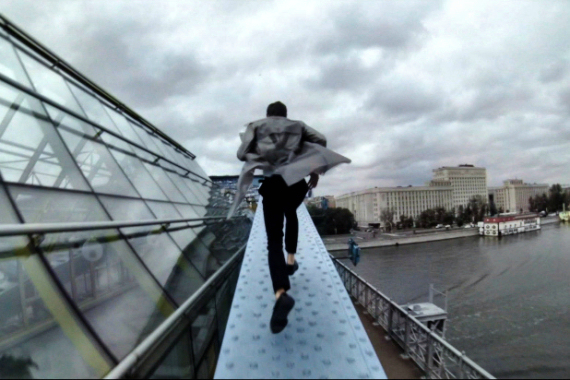
I’m late with the May/June F&SF review, and I have no excuse. How late? Well, this is the time the July/August review copies go out. I will, however, review that particular issue within the next couple of weeks, if that’s okay with you. As well, I plan to do extremely short reviews of some current movies in this column—I will eschew spoilers as usual, save for the usual little bits that somehow manage to slip by. The movies I’m going to talk about are a mixed bag: X-Men: Apocalypse, directed as usual by Bryan Singer; Disney’s Alice Through the Looking Glass—not directed by, but produced by, Tim Burton; and finally the new one from Timbur Bekmambetov, called Hardcore Henry, and starring Sharlto Copley. I only favour one of the three—I’ll tell you which one after the F&SF review—but all three have at least something to recommend them, or at least something I liked, which aren’t necessarily the same thing, are they?

The cover for the May/June F&SF is by an artist I’m not familiar with, Max Bertolini, but it certainly is striking! The predominant colour is a sort of lime green, odd enough for a cover, but the image is—more or less—right out of the cover story, which is Ted Kosmatka’s “The Stone War.” The cover depicts a near-naked warrior in mid-air, attacking what appears to be a man or statue made of stone (the warrior has something that could be a red/blue bird in his left hand (but a significant part of this image is covered by the F&SF banner); the statue, if that’s what it is, somewhat resembles a cruder version of Rodin’s The Thinker, with a clenched, empty left fist, crouched almost in a defensive position, with sharp-edged stone crystals growing out of its back. Quite intriguing, I think. When you open to the story itself, you find that the man in mid-air is one of many men who have attacked this statue over millennia. The stone man has been deified, vilified, worshipped, and attacked—and all but those who attack it find it is indifferent to them. Before the story ends, this thing will be the equivalent of an ICBM in a Mutual Assured Destruction scheme. A fable, or a parable? Quite an interesting story, and a good entree into this issue.
The longest story is by Pat McEwen, who is that rare thing: a person writing “Police Procedurals” who has actually been, as they say, On The Job. It appears McEwen spent a decade as a Crime Scene Investigator, has done war crimes investigations for the International Criminal Tribunal, currently holds a position as a consultant on archaeological matters involving human remains. Which fits, as “Coyote Song” involves a crime scene investigator named Yutu (which means “Coyote, Out Hunting” in Miwoksan. The Miwok were a Native American group which lived all over the Bay area of California, from Bodega Bay, Sonoma County and through Marin County), who is investigating a murder in—I’m guessing, because she never says—Marin County; it has to be a County, because Yutu works for a Sheriff’s Department. I could probably track it down through internal clues in the story, but it would be a waste of time that could be better spent reading this well-written story. I’m sure you will enjoy this, especially if you like Native American heritage legends (you do know who Coyote is, I assume), Khmer/Cambodian legend, voudun and police procedurals all mixed into one exciting tale. I enjoyed this one a lot, and will be looking for more of her stuff (McEwen’s) in the future. And I’m sure we’re not done with Yutu either.
The shortest story in this issue is by Jennifer Allora, Guillermo Calzadilla and Ted Chiang, and concerns—and this is a lot for such a short story—the Arecibo radio-telescope, the endangered Puerto Rican parrot, the Fermi Paradox and the last words of an African Grey Parrot named Alex. It also concerns sound and the nature of intelligence; it might make you sad. ‘Nuff said.
In case you haven’t noticed, I’m not doing these stories in the order they appear; I tend to jump around—and I don’t review the book review columns, etc., because those aren’t in my review copy. But that’s okay; it gives me more scope and flexibility. “Last of the Sharkspeakers,” by Brian Trent, is one of two stories in this issue about humanity moving into space. One that forecasts a change in humanity—an evolution, if you will—when we have finally (and I believe we will, eventually) “slipped the surly bonds of Earth” and migrated into space. This story takes place mostly in the asteroid Ceres, and involves a mutated human species and an unmutated one… guess which one is the one you’ll feel sympathy with? Nicely written!
The other story (of the two about humanity moving into space) takes place well before the Trent story, timewise, and involves how humans will change to fit a non-Earthly environment. ”The Long Fall Up,” by William Ledbetter, is about one woman’s struggle to prove that healthy children can be gestated and born in null-grav environments; and about a “corporate tool” who turns against his masters—the corporation that controls all life, including birth, in a Langrange Point habitat. (And perhaps his “ship’s cortex,” though not supposed to be a “true” AI, is closer to being that than its designers realized.)
“Steamboat Gothic,” by Albert E. Cowdrey, tells an improbable tale of Louisiana-style fiction; steeped in bayou magic (and jes’ drippin’ with Spanish Moss, y’know) and starring Sheriff Russell Chew, Jr., who is apparently modeled on a N’Awlins-area for-real sheriff. As I say, improbable, but no less fun for all that. And Sheriff Chew, though he has his fingers in many local pies, appears to be one of the good guys. (Not like our local sheriff, when I lived in Florida in the late 1950s, named B.J. “Doc” Baffin. Well, that’s not really his name; I’ve changed it a bit just in case someone accuses me of slander. Ol’ Doc “Baffin” was rumoured to have his fingers in just about everything illegal in “Bayou” County—yes, I changed the county’s name too, just to be safe—from moonshine stills to the occasional lynch mob. (You have to remember this was some years before the Civil Rights movement, when it was still the Old South.) Anyway, Doc “Baffin” was a Bad Guy who probably kept getting elected till he died—that’s the way things were don in those places at that time; Sheriff Chew is nothing like him, even though he appears to be able to bend the rules a bit to see that justice is done. Even if you’re not familiar with Louisiana, you’ll probably enjoy this semi-humorous morality tale.
“More Heat Than Light,” by Charlotte Ashley, is a bit of a treat for those of us on the northern side of the border; set in a North America in the latter part of the eighteenth century where France’s revolution in Québèc will probably not lead to today’s Canada, where monsters of Native superstition roam the woods. If you liked The Revenant, you’ll probably like this story. In fact, I didn’t find a single unlikeable story in the whole issue. Because I don’t like spoilers (even though they really don’t affect me—no, it’s true! You can tell me the whole plot of a movie I’m about to watch, and I can still enjoy it)—I’m not going to rate and describe every story in the magazine. The others are “The Nostalgia Calculator,” by Rich Larson (from Edmonton, Alberta!); “The Secret Mirror of Moriyama House” by Yukimi Ogawa (from Tokyo!); “Caribou: Documentary Fragments” by Joseph Tomaras; and a little chiller from Susan Palwick called “Ash.” Good stories, one and all; as you probably already know, F&SF is edited by C.C. Finlay, who was part of the recent StoryBundle curated by Lisa Mason that I reviewed here.

Now, on to the movie reviews. These will be shorties—not full-featured movie reviews; two of these films don’t deserve (in my opinion) full reviews, and the third one is a bit “out there”; my capsule review should suffice, though. To begin with, let me just say that Disney’s Alice Through The Looking Glass has a solid 6.4 on IMDB, and it doesn’t—at least in my opinion—deserve that. Maybe a 5. For one thing, like its predecessor, Alice In Wonderland, it is so loosely based on Lewis Carroll’s work as to barely share the same shelf. It has most of the same characters and actors as the earlier film: Johnny Depp, Mia Wasikowska, Anne Hathaway (although Crispin Glover has been replaced by Sacha Baron Cohen); they all play somewhat analogs of the Carroll characters… but the movie is still CGI-driven (not that CGI in itself is a bad thing; it’s just that when CGI replaces writing and acting as a film’s raison d’etre, the movie loses a great deal of watchability) and whole characters and incidents are made up of whole cloth. Yeah, I know, I’m somewhat of a purist when it comes to Alice; my sisters and I were brought up on the books with the John Tenniel illustrations, and this really suffers by comparison, especially in the writing. What did I like about it? Let’s see: some of the CGI, though overwhelming, was clever and cute: see Figure 3; these guardsmen owe a lot to the sixteenth-century Italian illustrator Guiseppe Arcimboldo. Though I abhor his makeup, Johnny Depp shines as The Mad Hatter; he takes a weak character and makes it his own; I love Tweedledum and Tweedledee, portrayed by Matt Lucas. While I don’t believe there were any female 18th-century British commercial ship captains (I could be wrong), I like looking at sailing ship portrayals, and CGI does those well. The other actors, notably Helena Bonham Carter and Sasha Baron Cohen, did the best they could with a lousy script. Otherwise, feh. (Click his name if you’ve never heard of Arcimboldo.)

X-Men: Apocalypse—Oh, my goodness! Where do I start with this movie? Talk about CGI instead of good writing! I have enjoyed good portions of the other X-Men movies, and I realize CGI has to be an integral part of any X-Men film, otherwise, you’d never be able to portray either the characters or their abilities. But giant CGI battles just don’t do it for me, and they’ve become the go-to plot device for Bryan Singer’s X-Men. And logic? Right out the window, I believe. This movie is all timey-wimey wibbly wobbly, as someone once said; these are all the younger X-Men (Jennifer Lawrence instead of Rebecca Romijn; James MacAvoy instead of Patrick Stewart; Nicholas Hoult instead of Kelsey Grammer; Michael Fassbender takes the place of Ian McKellan; Sophie Turner takes over from Famke Janssen and so on) and all this takes place after X-Men: Days of Future Past and before the first X-Men. Some things just don’t add up, though I don’t intend to attempt to justify that particular view. Sophie Turner is fine in Game of Thrones, but she’s no Famke, in my opinion. The best new character is Evan Peters, who appears for the second time (I think; I’d have to go back and look at X-Men: First Class again) as Quicksilver (Figure 1). I like the actor and the character he portrays. There’s even a quick cameo from someone who’s appeared in every X-Men movie so far (I mean besides Stan Lee), and it was welcome. I kind of liked the solar-powered ancient Egyptian printed-circuit boards—how did they keep all that gold molten, anyway?—but aside from those I just couldn’t buy into this movie. Sorry, Marvel. I like your Nightcrawler (no matter who plays him), but where is the “bamf”? Anyway—here’s my big problem with all the X-Men movies: I’ve never bought Marvel’s assertion that people will immediately hate and fear any person who displays mutant abilities, unless that person is using those abilities to hurt someone else. I don’t hate and/or fear (envy, maybe) people who can do things I can’t; I certainly wouldn’t disown my own children who displayed such abilities or ask them if they’d tried “not being a mutant.” I just don’t buy it, which for me takes away an awful lot from the movies.

And now we come to the one new movie I’ve seen this week that I really liked: Hardcore Henry! Now, this movie (which, from the credits, was at least partially funded by Indiegogo!) is not for everyone, which is why I’m not doing a full review. It takes a certain detachment to watch it (plus a fairly strong stomach) for two reasons: one, it’s non-stop action and violence from beginning to end—there’s someone getting killed at least every minute of screen time—as well as being filmed entirely in first-person! (And the viewpoint can cause nausea or motion sickness for some people.) I believe this may be the first feature film to use GoPro from beginning to end (see Figure 6). Produced by Timur Bekmambetov (Wanted), it was written and directed by Ilya Naishuller. It stars the South African actor/filmmaker Sharlto Copley as Jimmy; Danila Kozlovsky as Akan; Hayley Bennett as Estelle; with a cameo by Tim Roth as Henry’s father. The pace is frantic and frenetic (see Figure 5; the movie was made in Moscow because they have no rules forcing the actors and stuntpeople to wear harnesses; they had the freedom to get injured—fortunately, there were very few injuries on set. If you watch this film, someone is shot, stabbed, blown up, decapitated or burned alive darned near every minute; there’s a lot of blood and body parts, yet somehow it doesn’t seem any more offensive than, say, the first-person portion of Doom.

Figure 6 shows one of the three cameramen who wore the GoPros. The plot is fairly simple: Henry wakes up and finds his body is missing a few parts; a woman (Bennett) who says she’s his wife adds on his left arm and leg, explaining that he was (more or less) killed and they’ve basically made him a cyborg. Before she can activate his voicebox, armed people have invaded the room and he is forced to flee the airplane he’s in. Later, he meets Jimmy (Copley), who appears to be on his side, and who is killed while helping him escape; still later he meets Jimmy again, who is inexplicably alive again. Henry’s running from Akan (Kozlovksy), a warlord who wants to create an army of cyborg soldiers (Henry’s a prototype), and who appears to have telekinetic powers. The movie, as I said earlier, is basically all running and killing. As far as I know, the action is all live-action, combining parkour and some pretty incredible athletics. (I’m wondering if some wires, however, were painted out in post-production… I’ll have to check the credits for rotoscopers.) If violence doesn’t bother you—especially non-stop killing—and if you like a movie that almost literally never stops for a minute, then Hardcore Henry just might be your kind of movie.
Last words: Hey, June 15 is the first day to vote for the Aurora Awards, fellow Canadians. You only have to pay your $10 annual membership to the CSFFA (the Canadian SF/F Association) and you’ll receive the Voters’ Packet, which contains ALL nominated works: that’s over 10 novels, anthologies, poems, graphic novels, poems and more! If you’ve not yet joined, click the above link and do so! And if you like my column, you can vote for me under “Best Fan Related Work.” That’s a subtle hint, you know, *cough* *cough*!
Please comment on this week’s column—if you feel like it. You can either comment here or on my Facebook page, or in the several Facebook groups where I publish a link to this column. Whether I agree with your comments or not, they’re all welcome, so don’t feel you have to agree with me to post a comment. My opinion is, as always, my own, and doesn’t necessarily reflect the views of Amazing Stories or its owners, editors, publishers or other columnists. See you next week!











1 Comment